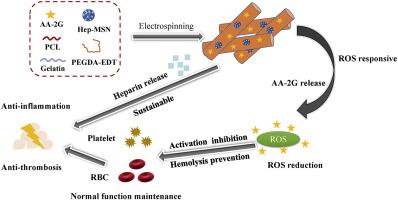当前位置:
X-MOL 学术
›
Mater. Today Chem.
›
论文详情
Our official English website, www.x-mol.net, welcomes your
feedback! (Note: you will need to create a separate account there.)
Programmable release of 2-O-d-glucopyranosyl-l-ascorbic acid and heparin from PCL-based nanofiber scaffold for reduction of inflammation and thrombosis
Materials Today Chemistry ( IF 6.7 ) Pub Date : 2020-09-01 , DOI: 10.1016/j.mtchem.2020.100303 H. Wang , Y. Xia , J. Liu , Z. Ma , Q. Shi , J. Yin
Materials Today Chemistry ( IF 6.7 ) Pub Date : 2020-09-01 , DOI: 10.1016/j.mtchem.2020.100303 H. Wang , Y. Xia , J. Liu , Z. Ma , Q. Shi , J. Yin

|
Abstract Reduction of inflammation and thrombosis caused by implanted devices is critical for clinical success. To this end, the strategy based on programmable release of anti-inflammatory and anti-thrombotic agents from the widely-used polycaprolactone (PCL)/gelatin nanofiber scaffold is developed. The release of 2-O- d -Glucopyranosyl- l -ascorbic Acid (AA-2G) and heparin are controlled by reactive oxygen species (ROS)-responsive poly(ethylene glycol)-based β-thioether ester copolymer (PEGDA-EDT) and mesoporous silica nanoparticles (MSN) in the nanofiber, respectively. The in vitro assay demonstrate that the scaffolds are hemocompatible with the resistance of platelet adhesion; the control release of AA-2G prevents initial inflammation and oxidation of the blood cells, and the subsequent release of heparin entitles nanofibers with long-term anti-thrombotic capability. In addition, rapid endothelialization is obtained on the surface of nanofiber scaffolds for the further enhancement of the hemocompatibility. In vivo implant evaluation convinces that the nanofiber scaffolds possess high biocompatibility with the substantial resistance for inflammation and thrombosis. Hence, our work paves a new way to develop the anti-inflammatory and anti-thrombotic tissue-engineering substrates through programmable delivery of two or multiple drugs.
中文翻译:

从基于 PCL 的纳米纤维支架中可编程释放 2-Od-吡喃葡萄糖基-l-抗坏血酸和肝素,以减少炎症和血栓形成
摘要 减少由植入装置引起的炎症和血栓形成对于临床成功至关重要。为此,开发了基于从广泛使用的聚己内酯 (PCL)/明胶纳米纤维支架中可编程释放抗炎和抗血栓形成剂的策略。2-O-d-吡喃葡萄糖基-l-抗坏血酸(AA-2G)和肝素的释放受活性氧(ROS)响应性聚(乙二醇)基β-硫醚酯共聚物(PEGDA-EDT)控制和纳米纤维中的介孔二氧化硅纳米粒子(MSN)。体外试验证明支架与血小板粘附抗性是血液相容的;AA-2G 的控制释放可防止血细胞的初始炎症和氧化,随后肝素的释放使纳米纤维具有长期抗血栓形成的能力。此外,在纳米纤维支架表面获得快速内皮化,以进一步增强血液相容性。体内植入物评估表明,纳米纤维支架具有很高的生物相容性,并且对炎症和血栓形成具有很强的抵抗力。因此,我们的工作为通过两种或多种药物的可编程递送开发抗炎和抗血栓形成的组织工程基质铺平了道路。体内植入物评估表明,纳米纤维支架具有很高的生物相容性,并且对炎症和血栓形成具有很强的抵抗力。因此,我们的工作为通过两种或多种药物的可编程递送开发抗炎和抗血栓形成的组织工程基质铺平了道路。体内植入物评估表明,纳米纤维支架具有很高的生物相容性,并且对炎症和血栓形成具有很强的抵抗力。因此,我们的工作为通过两种或多种药物的可编程递送开发抗炎和抗血栓形成的组织工程基质铺平了道路。
更新日期:2020-09-01
中文翻译:

从基于 PCL 的纳米纤维支架中可编程释放 2-Od-吡喃葡萄糖基-l-抗坏血酸和肝素,以减少炎症和血栓形成
摘要 减少由植入装置引起的炎症和血栓形成对于临床成功至关重要。为此,开发了基于从广泛使用的聚己内酯 (PCL)/明胶纳米纤维支架中可编程释放抗炎和抗血栓形成剂的策略。2-O-d-吡喃葡萄糖基-l-抗坏血酸(AA-2G)和肝素的释放受活性氧(ROS)响应性聚(乙二醇)基β-硫醚酯共聚物(PEGDA-EDT)控制和纳米纤维中的介孔二氧化硅纳米粒子(MSN)。体外试验证明支架与血小板粘附抗性是血液相容的;AA-2G 的控制释放可防止血细胞的初始炎症和氧化,随后肝素的释放使纳米纤维具有长期抗血栓形成的能力。此外,在纳米纤维支架表面获得快速内皮化,以进一步增强血液相容性。体内植入物评估表明,纳米纤维支架具有很高的生物相容性,并且对炎症和血栓形成具有很强的抵抗力。因此,我们的工作为通过两种或多种药物的可编程递送开发抗炎和抗血栓形成的组织工程基质铺平了道路。体内植入物评估表明,纳米纤维支架具有很高的生物相容性,并且对炎症和血栓形成具有很强的抵抗力。因此,我们的工作为通过两种或多种药物的可编程递送开发抗炎和抗血栓形成的组织工程基质铺平了道路。体内植入物评估表明,纳米纤维支架具有很高的生物相容性,并且对炎症和血栓形成具有很强的抵抗力。因此,我们的工作为通过两种或多种药物的可编程递送开发抗炎和抗血栓形成的组织工程基质铺平了道路。











































 京公网安备 11010802027423号
京公网安备 11010802027423号